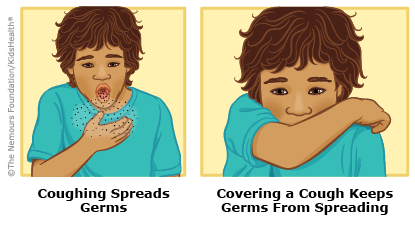Chilling Out With Colds
You wake up in a cranky mood. Your head hurts. You don't have the energy to even get out of bed. And you can't breathe out of your nose. What's wrong? You may have a cold!
Having a cold is the #1 reason kids visit the doctor and stay home from school. Kids can get six to ten colds per year with each cold lasting an average of 7 to 14 days. Let's find out more about them.
What Is a Cold?
A cold is an infection of the upper respiratory system. This just means it can affect the nose, throat, and sinuses. A cold virus gets inside your body and makes you sick. The rhinovirus (say: rye-no-VYE-rus) is the most common cold virus, but more than 200 viruses can cause colds. Because there are so many, there isn't a vaccination, or shot, to prevent you from getting colds.

Fortunately, your body already has the best cold cure — your immune system. The immune system defends your body against illness. White blood cells are the immune system's main warriors. They're your own private army working to help you feel better. Take that, cold viruses!
How Kids Catch Colds
Mucus (say: MYOO-kus) is wet, slimy stuff inside the nose, mouth, and throat. When someone sneezes or coughs, mucus drops float in the air. Breathing in these droplets can spread a cold from one person to another.
You also can catch a cold if you touch your eyes, nose, or mouth after handling something with cold viruses on it. Video games, the doors at the mall, and your school desk are all hot spots for viruses. So be sure to wash your hands regularly.
Getting a cold works like space travel: The virus actually has docking points that stick to the inside of your nose — just like a small spaceship attaching to a mother ship! The virus takes over the cells lining the nose and begins creating more viruses.
White blood cells charge to the nose's rescue and cause cold symptoms, while also killing the virus that caused the cold. Runny noses and sneezing actually help to prevent viruses from invading other parts of your body.
You sneeze because your nerves detect the irritation in your nose and get the lungs to push a blast of air out through your nose and mouth. A sneeze can travel at more than 100 miles (161 kilometers) an hour — faster than a car travels on the road, unless you're at a racetrack!
Cold Clues
Symptoms (say: SIMP-tumz) are signs or clues that tell doctors you're sick. Once you've been in contact with a cold virus, it takes 2 to 3 days for cold symptoms to begin. You may have some of the following symptoms with a cold:
- low fever (100-101ºF / 37.2-37.8ºC)
- body chills
- itchy or sore throat
- sneezing, runny nose, and watery eyes
- coughing
- feeling tired and not hungry
- congestion (when your nose is stuffy and it's hard to breathe)
Helping Kids Feel Better
Here are some feel-better tips:
- Bring on the heat. Hot drinks soothe coughs and sore throats while also clearing mucus. So eat (or drink) your chicken soup!
- Get steamed up. A steamy shower helps stuffy or irritated noses. Or run a humidifier (a small, quiet machine that sprays fine cool mist in the air) to relieve your scratchy throat and stuffy nose. Humidifiers make room air moist, which loosens mucus.
- Practice healthy habits. Your immune system will be ready to fight colds if you eat a balanced diet, get plenty of sleep, and keep your body fit through regular exercise.
- Blow your horn. Blowing your nose is the best way to get rid of mucus.
- Rest. Take a nap or go to bed a little earlier for a few nights.
- De-stress. Kids who are stressed out feel worse when they have colds. Relax and use the time to read, listen to music, or watch a movie. In other words, chill out and you might prevent a cold!
Reviewed by: Larissa Hirsch, MD
Date reviewed: January 2014
Originally reviewed by: Kevin P. Sheahan, MD
Note: All information is for educational purposes only. For specific medical advice, diagnoses, and treatment, consult your doctor.
© 1995-2024 KidsHealth ® All rights reserved. Images provided by iStock, Getty Images, Corbis, Veer, Science Photo Library, Science Source Images, Shutterstock, and Clipart.com


